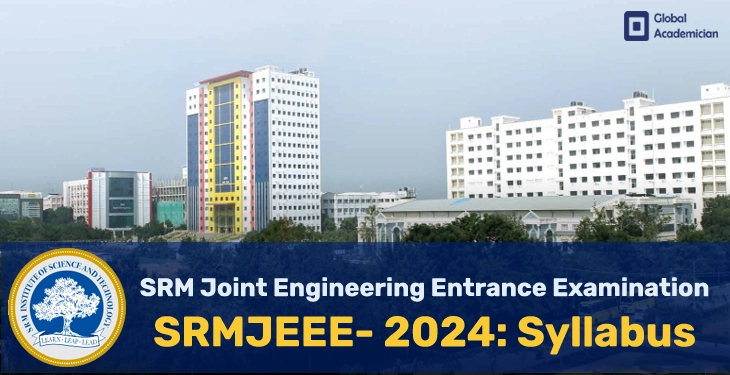
|
Embarking on the SRMJEEE 2024 journey requires a comprehensive understanding of the syllabus, the roadmap to success in this national-level engineering entrance exam. The SRMJEEE 2024 Syllabus is the compass guiding aspiring students through the realms of Physics, Chemistry, Mathematics, Biology (for Biotechnology aspirants), English, and Aptitude. This page serves as a detailed guide, unraveling the key topics and subject areas essential for exam preparation. Aspirants are encouraged to delve into this comprehensive syllabus, equipping themselves with the knowledge necessary to navigate each phase of the examination with confidence. Let’s embark on this academic expedition, exploring the syllabus that lays the foundation for success in SRMJEEE 2024.
SRMJEEE 2024 Syllabus:
- Physics Syllabus 2024
- Chemistry Syllabus 2024
- Mathematics Syllabus 2024
- Biology Syllabus 2024
- English Syllabus 2024
- Aptitude Syllabus 2024
1. Physics Syllabus 2024:
Physics: Unit 01: Units and Measurement, Mechanics
- Units for measurement, system of units-SI, fundamental and derived units, measurements-errors in measurement, significant figures, dimensions-dimensional analysis, applications
- Laws of motion: Newton’s laws of motion, force and inertia, impulse and momentum, law of conservation of linear momentum-applications, projectile motion, uniform circular motion, friction-laws of friction, applications, centripetal force
- Work, energy, and power: Work, energy-potential energy and kinetic energy, power, collision-elastic and inelastic collisions
Physics: Unit 02: Gravitation, mechanics of solids and fluids
- Gravitation: The universal law of gravitation, acceleration due to gravity-variation of ‘g’ with altitude, latitude and depth, gravitation potential, escape velocity and orbital velocity, geostationary satellites, Kepler’s laws of planetary motion
- Mechanics of solids and fluids: Solids, elastic behaviour, stress-strain, Hooke’s law, modulli of elasticity-relation between them, surface tension capillarity-applications, viscosity, Poiseuille’s formula, Stokes’ law applications
- Mechanics of solids and fluids: Streamline and turbulent flow, Reynolds number, Bernoulli’s theorem-applications
Physics: Unit 03: Electrostatics
- Electric charge-conservation laws, Coulomb’s law-principle of superposition, continuous charge distribution, electric field-electric field lines, electric dipole-electric field due to a dipole, torque on a dipole in uniform electric field, electric flux
- Gauss’s theorem-field due to infinitely long straight wire, uniformly charged infinite plane sheet and uniformly charged thin spherical shell
- Electric potential-potential difference, equipotential surfaces, electrical potential energy, dielectrics and electric polarization, capacitors and capacitance-combination of capacitors in series and in parallel
- Capacitance of a parallel plate capacitor with and without dielectric medium, energy stored in a capacitor
Physics: Unit 04: Current electricity
- Electric current, drift velocity, Ohm’s law-V-I characteristics, electrical energy and power, electrical resistivity and conductivity, carbon resistors, series and parallel combinations of resistors, temperature dependence, internal resistance of a cell.
- Potential difference and EMF of a cell, combination of cells in series and in parallel, Kirchhoff’s laws, applications, Wheatstone bridge, metre bridge, potentiometer, comparison of EMF of two cells, measurement of internal resistance of a cell.
Physics: Unit 05: Magnetism and Magnetic effects of current
- Earth’s magnetic field and magnetic elements, magnetic field due to a magnetic dipole, torque on a magnetic dipole, tangent law, tangent galvanometer deflection magnetometer, magnetic properties of a material.
- Dia-, para-, and ferro-magnetic materials, applications.
- Magnetic effects of electric current, Biot Savart’s law, force on a moving charge in an uniform magnetic field, moving coil galvanometer, conversion of a galvanometer into voltmeter and ammeter.
Physics: Unit 06: Electromagnetic induction, alternating currents, and electromagnetic waves
- Electromagnetic induction, Faraday’s laws, induced EMF and current, Lenz’s Law, eddy currents, self and mutual induction, alternating currents, peak and RMS value of alternating current/ voltage, reactance and impedance, LC oscillations.
- LCR series circuit, resonance, power in AC circuits, power factor, wattles current, AC generator and transformer, electromagnetic waves characteristics, electromagnetic spectrum.
Physics: Unit 07: Optics
- Reflection of light, spherical mirrors-mirror formula, refraction of light, total internal reflection optical fibers, refraction at spherical surfaces, lenses-thin lens formula, lens maker’s formula, magnification, power of a lens.
- Combination of thin lenses in contact, refraction of light through a prism, scattering of light, microscopes and astronomical telescopes.
- Wave front and Huygens’s principle, reflection and refraction of plane wave at a plane surface, laws of reflection and refraction using Huygens’s principle, interference, Young’s double slit experiment and expression for fringe width.
- Diffraction due to a single slit, width of central maximum, polarization, plane polarised light, Brewster’s law.
Physics: Unit 08: Dual nature of radiation and matter, and atomic physics
- Dual nature of radiation, photoelectric effect, Hertz and Lenard’s observations, Einstein’s photoelectric equation, particle nature of light.
- Matter waves-wave nature of particles, De-Broglie relation, Davisson-Germer experiment, alpha-particle scattering experiment, Rutherford’s model of atom, Bohr model, hydrogen spectrum.
Physics: Unit 09: Nuclear physics
- Nuclear radius, mass, binding energy, density, isotopes, mass defect-Bainbridge mass spectrometer, nuclear forces neutron discovery, radioactivity, α, β and γ decay-half life-mean life, artificial radio activity, radio isotopes, radio carbon dating.
- Radiation hazards.
- Nuclear fission, nuclear reactor, nuclear fusion, hydrogen bomb, cosmic rays, elementary particles.
Physics: Unit 10: Electronic devices
- Semiconductors, doping-types, PN junction diodes, LED, photodiode, solar cell and Zener diode-characteristics, Zener diode as a voltage regulator, transistors-transistor characteristics, amplifier, gain, feedback in amplifiers.
- Logic gates-basic logic gates, NOT, OR, AND, NOR, NAND, universal gates, De Morgan’s theorems.
2. Chemistry Syllabus 2024:
Chemistry: Unit 01: Solutions
- Types of solutions, expression of concentration of solutions of solids in liquids, solubility of gases in liquids, solid solutions, colligative properties-relative lowering of vapour pressure, Raoult’s law, elevation of boiling point.
- Depression of freezing point, osmotic pressure, determination of molecular masses using colligative properties, abnormal molecular mass, Van’t Hoff factor.
Chemistry: Unit 02: Electrochemistry
- Redox reactions, conductance in electrolytic solutions, specific and molar conductivity, variations of conductivity with concentration, Kohlrausch’s Law, electrolysis and law of electrolysis (elementary idea).
- dry cell-electrolytic cells and Galvanic cells, EMF of a cell, standard electrode potential, Nernst equation and its application to chemical cells, Relation between Gibbs energy change and EMF of a cell, fuel cells, corrosion.
Chemistry: Unit 03: Chemical kinetics
- Rate of a reaction (Average and instantaneous), factors affecting rate of reaction: concentration, temperature, catalyst; order and molecularity of a reaction, rate law and specific rate constant.
- Integrated rate equations and half-life (only for zero and first order reactions), concept of collision theory (elementary idea, no mathematical treatment), activation energy, Arrhenius equation.
Chemistry: Unit 04: Surface chemistry
- Adsorption-physisorption and chemisorption, factors affecting adsorption of gases on solids, catalysis, homogenous and heterogenous activity, and selectivity; enzyme catalysis colloidal state distinction between true solutions, colloids and suspension.
- Lyophilic, lyophobic multimolecular, and macromolecular colloids; properties of colloids; Tyndall effect, Brownian movement, electrophoresis, coagulation, emulsion-types of emulsions.
Chemistry: Unit 05: General principles and processes of isolation of elements
- Principles and methods of extraction-concentration, oxidation, reduction-electrolytic method and refining.
Chemistry: Unit 06: P-block elements
- Group 16 elements: General introduction, electronic configuration, oxidation states, occurrence, trends in physical and chemical properties, dioxygen: Preparation, properties, and uses, classification of oxides, ozone, sulphur-allotropic forms.
- Group 16 elements: Compounds of sulphur-preparation properties, and uses of sulphur-dioxide, sulphuric acid: Industrial process of manufacture, properties, and uses; oxoacids of sulphur (structures only).
- Group 17 elements: General introduction, electronic configuration, oxidation states, occurrence, trends in physical and chemical properties; compounds of halogens, preparation, properties, and uses of chlorine and hydrochloric acid, interhalogen compounds.
- Group 17 elements: Oxoacids of halogens (structures only).
- Group 18 Elements: General introduction, electronic configuration, occurrence, trends in physical and chemical properties, uses.
Chemistry: Unit 07: D and f block elements
- General introduction, electronic configuration, occurrence, and characteristics of transition metals, general trends in properties of the first row transition metals-metallic character, ionization enthalpy, oxidation states, ionic radii, colour.
- Catalytic property, magnetic properties, interstitial compounds, alloy formation lanthanides-electronic configuration, oxidation states, chemical reactivity and lanthanide contraction, and its consequences.
Chemistry: Unit 08: Coordination compounds
- Coordination compounds-introduction, ligands, coordination number, colour, magnetic properties and shapes, IUPAC nomenclature of mononuclear coordination compounds.
- Bonding, Werner’s theory, VBT and CFT; structure and stereoisomerism, importance of coordination compounds (in qualitative inclusion, extraction of metals and biological system).
Chemistry: Unit 09: Haloalkanes and Haloarenes
- Haloalkanes: Nomenclature, nature of C-X bond, physical and chemical properties, mechanism of substitution reactions, optical rotation.
- Haloarenes: Nature of C-X bond, substitution reactions (Directive influence of halogen in monosubstituted compounds only).
- Uses and environmental effects of-dichloromethane, trichloromethane, tetrachloromethane, iodoform, freons, DDT.
Chemistry: Unit 10: Alcohols, phenols, and ethers
- Alcohols: Nomenclature, methods of preparation, physical and chemical properties (of primary alcohols only), identification of primary, secondary, and tertiary alcohols, mechanism of dehydration, uses with special reference to methanol and ethanol.
- Phenols: Nomenclature, methods of preparation, physical and chemical properties, acidic nature of phenol, electrophilic substitution reactions, uses of phenols.
- Ethers: Nomenclature, methods of preparation, physical and chemical properties, uses.
Chemistry: Unit 11: Aldehydes, ketones, and carboxylic acids
- Aldehydes and Ketones: Nomenclature, nature of carbonyl group, methods of preparation, physical and chemical properties, mechanism of nucleophilic addition, reactivity of alpha hydrogen in aldehydes, uses.
- Carboxylic Acids: Nomenclature, acidic nature, methods of preparation, physical and chemical properties; uses.
Chemistry: Unit 12: Organic compounds containing nitrogen
- Amines: Nomenclature, classification, structure, methods of preparation, physical and chemical properties, uses, identification of primary, secondary and tertiary amine. Cyanides and Isocyanides.
- Diazonium salts: Preparation, chemical reactions, and importance in synthetic organic chemistry.
Chemistry: Unit 13: Biomolecules
- Carbohydrates: Classification (aldoses and ketoses), monosaccahrides (glucose and fructose), D-L configuration oligosaccharides (sucrose, lactose, maltose), polysaccharides (starch, cellulose, glycogen); importance of carbohydrates.
- Proteins: Elementary idea of-amino acids, peptide bond, polypeptides, proteins, structure of proteins-primary, secondary, tertiary structure and quaternary structures (qualitative idea only), denaturation of proteins; enzymes.
- Vitamins: Classification and functions. Nucleic acids: DNA and RNA.
Chemistry: Unit 14: Polymers
- Copolymerization, some important polymers: Natural and synthetic like polythene, nylon polyesters, bakelite, and rubber.
- Biodegradable and non-Biodegradable polymers.
Chemistry: Unit 15: Chemistry in everyday life
- Chemicals in medicines-analgesics, tranquilizers antiseptics, disinfectants, antimicrobials, antifertility drugs, antibiotics, antacids, antihistamines.
- Chemicals in food-preservatives, artificial sweetening agents, elementary idea of antioxidants.
- Cleansing agents-soaps and detergents, cleansing action.
3. Mathematics Syllabus 2024:
Mathematics: Unit 01: Sets, relations and functions
- Sets and their representations, union, intersection and complements of sets, and their algebraic properties, relations, equivalence relations, mappings, one-one, into and onto mappings, composition of mappings
Mathematics: Unit 02: Complex numbers and quadratic equations
- Complex numbers in the form a+ib and their representation in a plane
- Argand diagram
- Algebra of complex numbers, modulus and argument of a complex number, square root of a complex number
- Cube roots of unity, triangle inequality
- Quadratic equations in real and complex number system, and their solutions
- Relation between roots and coefficients, nature of roots, formation of quadratic equations with given roots
- Symmetric functions of roots, equations reducible to quadratic equations
Mathematics: Unit 03: Matrices, determinants and their applications
- Determinants and matrices of order two, and three, properties of determinants, evaluation of determinants, addition and multiplication of matrices, adjoint and inverse of matrix
- Computing the rank of a matrixtest of consistency and solution of simultaneous linear equations using determinants, and matrices.
Mathematics: Unit 04: Combinatorics
- Permutations and combinations: Fundamental principle of counting-permutation as an arrangement and combination as selection, meaning of P (n,r) and C (n,r). Simple applications
- Mathematical induction and its applications: Stating and interpreting the principle of mathematical induction. Using it to prove formula and facts
Mathematics: Unit 05: Algebra
- Binomial theorem and its applications: Binomial theorem for a positive integral index; general term and middle term; binomial theorem for any index. properties of binomial coefficients. Simple applications for approximations
- Sequences and series: Arithmetic, geometric, and harmonic progressions. Insertion of arithmetic, geometric, and harmonic means between two given numbers. Relation between A.M., G.M., and H.M. arithmetic, geometric series
- Sequences and series: Exponential and logarithmic series
Mathematics: Unit 06: Differential calculus and its applications
- Polynomials, rational, trigonometric, logarithmic, and exponential functions
- Inverse functions
- Graphs of simple functions
- Limits, continuity, differentiation of the sum, difference, product, and quotient of two functions, differentiation of trigonometric, inverse trigonometric, logarithmic, exponential, composite and implicit functions, derivatives of order up to two
- Applications of differential calculus: Rate of change of quantities, monotonic-increasing and decreasing functions, maxima and minima of functions of one variable, tangent and normals, Rolle’s and Lagrange’s mean value theorems
- Applications of differential calculus: Ordinary differential equations their order and degree. Formation of differential equations. Solution of differential equations by the method of separation of variables
- Applications of differential calculus: Solutions of homogeneous of linear differential equations and of the type dy/dx + p(x)y=q(x)
Mathematics: Unit 07: Integral calculus and its applications
- Integral as an anti-derivative
- Fundamental integrals involving algebraic, trigonometric, exponential and logarithmic functions
- Integration by substitution, by parts, and by partial fractions
- Integration using trigonometric identities
- Integral as limit of a sum
- Properties of definite integrals
- Evaluation of definite integrals; determining areas of the regions bounded by simple curves
Mathematics: Unit 08: Analytical geometry
- Straight lines in two dimensions: Cartesian system of rectangular coordinates in plane, distance formula, area of a triangle, condition for the collinearity of three points and section formula, centroid and incentre of a triangle, locus and its equation
- Straight lines in two dimensions: Translation of axes, slope of a line, parallel and perpendicular lines, intercepts of a line on the coordinate axes
- Circles in two dimensions: Standard form of equation of a circle, general form of the equation of a circle, its radius and centre, equation of a circle in the parametric form, equation of a circle when the end points of a diameter are given
- Circles in two dimensions: Points of intersection of a line and a circle with the centre at the origin and condition for a line to be tangent to the circle
- Conic sections in two dimensions: Sections of cones, equations of conic sections (parabola, ellipse, and hyperbola) in standard form, condition for y = mx+c to be a tangent and point(s) of tangency
Mathematics: Unit 09: Vector algebra
- Vectors and scalars, addition of vectors, components of a vector in two dimensions and three dimensional space, scalar and vector products, scalar and vector triple product
- Application of vectors to plane geometry
Mathematics: Unit 10: Statistics and Probability distribution
- Measures of central tendency and dispersion: Calculation of mean, median, and mode of grouped and ungrouped data
- Calculation of standard deviation, variance and mean deviation for grouped and ungrouped data
- Probability: Probability of an event, addition and multiplication theorems of probability, and their applications; conditional probability; Baye’s theorem, probability distribution of a random variable
- Probability: Binomial and Poisson distributions, and their properties
Mathematics: Unit 11: Trigonometry
- Trigonometry ratios, compound angles, trigonometrical equations, solution of triangles, Trigonometrically identities and equations-Inverse trigonometric functions and their properties.
- Properties of triangles, including, incentre, circumcentre and orthocenter, solution of triangles.
4. Biology Syllabus 2024:
Biology: Unit 01: Diversity in living world
- Biodiversity, importance of classifications, taxonomy and systematics, concept of species and taxonomical hierarchy, binomial nomenclature, tools for study of taxonomy
- Five kingdom classification: Monera, protista, and fungi into major groups; lichens; viruses and viroids. Salient features of them
- Classification of plants into major groups: Algae, bryophytes, pteridophytes, gymnosperm and angiosperm-salient and distinguishing features. Angiosperms-classification up to class, characteristic features and examples
- Classification of animals: Non chordate up to phyla level and chordate up to class’s level-salient, and distinguishing features.
Biology: Unit 02: Structural organization in animals and plants
- Plant tissues: Morphology and modifications, tissues, anatomy, and functions of different parts of flowering plants: Root, stem, leaf, inflorescence, flower, fruit, and seed
- Animal tissues: Morphology, anatomy, and functions of different systems (digestive, circulatory, respiratory, nervous, and reproductive) of an insect (cockroach)
Biology: Unit 03: Cell structure and function
- Cell theory, structure of prokaryotic, and eukaryotic cell, plant cell and animal cell
- Cell envelope, cell membrane, cell wall
- Cell organelles-structure and function: Endomembrane system-endoplasmic reticulum, golgi bodies, lysosomes, vacuoles, mitochondria, ribosomes, plastids, microbodies: Cytoskeleton, cilia, flagella, centrioles
- Nuclear membrane, chromatin, nucleolus
- Chemical constituents of living cells: Biomolecules-structure and function of proteins including enzymes-types, properties, enzyme action, carbohydrates, lipid, and nucleic acids
- Cell division: Cell cycle, mitosis, meiosis, and their significance
Biology: Unit 04: Plant physiology
- Transport in plants: Movement of water, gases, and nutrients, cell to cell transport-diffusion, active transport; plant-water relations, imbibition, water potential, osmosis, plasmolysis; long distance, transport of water-absorption, apoplast, symplast
- Transport in plants: Transpiration pull, root pressure, and guttation; transpiration-opening and closing of stomata; uptake and translocation of mineral nutrients-transport of food, phloem transport
- Mineral nutrition: Essential minerals, macro and micronutrients, and their role, deficiency symptoms, mineral toxicity, elementary idea of hydroponics, nitrogen metabolism
- Photosynthesis: Significance, site of photosynthesis, photochemical and biosynthetic phases of photosynthesis, cyclic and non cyclic photophosphorylation; chemiosmotic hypothesis; photorespiration; C3 and C4 pathways; factors affecting photosynthesis
- Respiration: Cellular respiration-glycolysis, fermentation (anaerobic), Kreb’s cycle and electron transport system (aerobic); energy relations-number of ATP molecules generated; amphibolic pathways; respiratory quotient
- Plant growth and development: Seed germination, phases of plant growth and plant growth rate, conditions of growth, differentiation, dedifferentiation, and redifferentiation, sequence of developmental process in a plant cell
- Growth regulators: Auxin, gibberellin, cytokinin, ethylene, ABA. Seed dormancy, photoperiodism, vernalisation
Biology: Unit 05: Human physiology
- Digestion and absorption: Alimentary canal and digestive glands, role of digestive enzymes and gastrointestinal hormones, peristalsis, digestion, absorption and assimilation of proteins, carbohydrates and fats, calorific value of proteins
- Digestion and absorption: Carbohydrates and fats, egestion; nutritional and digestive disorders-PEM, indigestion, constipation, vomiting, jaundice, diarrhea
- Breathing and respiration: Respiratory organs in animals, respiratory system in humans, mechanism of breathing and its regulation in humans-exchange of gases, transport of gases, and regulation of respiration, respiratory volumes
- Breathing and respiration: Disorders related to respiration-asthma, emphysema, occupational respiratory disorders
- Body fluids and circulation: Composition of blood, blood groups, coagulation of blood, composition of lymph and its function, human circulatory system-structure of human heart and blood vessels, cardiac cycle, cardiac output, ECG, double circulation
- Body fluids and circulation: Regulation of cardiac activity, disorders of circulatory-hypertension, coronary artery disease, angina pectoris, heart failure
- Excretory products and their elimination: Modes of excretion-ammonotelism, ureotelism, uricotelism, human excretory system-structure and function, urine formation, osmoregulation, regulation of kidney function-renin, angiotensin, atrial natriuretic factor
- Excretory products and their elimination: ADH and diabetes insipidus, role of other organs in excretion, disorders-uraemia, renal failure, renal calculi, nephritis, dialysis, and artificial kidney
- Locomotion and movement: Types of movement-ciliary, flagellar, muscular, skeletal muscle-contractile proteins and muscle contraction, skeletal system and its functions, joints, disorders of muscular and skeletal system-myasthenia gravis, tetany
- Locomotion and movement: Muscular dystrophy, arthritis, osteoporosis, gout
- Neural control and coordination: Neuron and nerves, nervous system in humans-central nervous system, peripheral nervous system, and visceral nervous system, generation and conduction of nerve impulse, reflex action, sensory perception, sense organs
- Neural control and coordination: Elementary structure and function of eye, and ear
- Chemical coordination and regulation: Endocrine glands and hormones, human endocrine system-hypothalamus, pituitary, pineal, thyroid, parathyroid, adrenal, pancreas, gonads. Mechanism of hormone action, role of hormones as messengers and regulators
- Chemical coordination and regulation: Hypo-and hyperactivity and related disorders-common disorders example dwarfism, acromegaly, cretinism, goiter, exopthalmic goiter, diabetes, Addison’s disease
Biology: Unit 06: Reproduction
- Reproduction in organisms: Reproduction, a characteristic feature of all organisms for continuation of species, modes of reproduction-asexual and sexual reproduction, asexual reproduction-binary fission, sporulation, budding, gemmule formation
- Reproduction in organisms: Fragmentation, vegetative propagation in plants
- Sexual reproduction in flowering plants: Flower structure, development of male and female gametophytes, pollination- types, agencies, and examples, out breeding devices, pollen-pistil interaction, double fertilization, post fertilization events
- Sexual reproduction in flowering plants: Development of endosperm and embryo, development of seed and formation of fruit, special modes apomixes, parthenocarpy, polyembryony, significance of seed dispersal and fruit formation
- Human reproduction: Male and female reproductive systems, microscopic anatomy of testis and ovary, gametogenesis- spermatogenesis and oogenesis, menstrual cycle, fertilization, embryo development up to blastocyst formation, implantation
- Human reproduction: Pregnancy and placenta formation, parturition, lactation
- Reproductive health: Need for reproductive health and prevention of sexually transmitted diseases (STDs), birth control need and methods, contraception and medical termination of pregnancy (MTP), amniocentesis
- Reproductive health: Infertility and assisted reproductive technologies-IVF, ZIFT, GIFT.
Biology: Unit 07: Genetics and evolution
- Principles of inheritance and variation: Heredity and variation, Mendelian inheritance, deviations from Mendelism-incomplete dominance, codominance, multiple alleles and inheritance of blood groups, pleiotropy, polygenic inheritance
- Principles of inheritance and variation: Chromosome theory of inheritance, chromosomes and genes, sex determination in humans, birds and honey bee, linkage and crossing over, sex linked inheritance-haemophilia, colour blindness
- Principles of inheritance and variation: Thalassemia, chromosomal disorders in humans, Down’s syndrome, Turner’s, and Klinefelter’s syndromes
- Molecular basis of inheritance: DNA as genetic material, structure of DNA and RNA, DNA packaging and replication, central dogma, transcription, genetic code, translation, gene expression and regulation-lac operon
- Molecular basis of inheritance: Genome and human and rice genome projects, DNA fingerprinting
- Evolution: Origin of life, biological evolution and evidences for biological evolution (paleontology, comparative anatomy, embryology, and molecular evidences), Darwin’s contribution, modern synthetic theory of evolution, mechanism of evolution
- Evolution: Variation (mutation and recombination) and natural selection with examples, types of natural selection; gene flow and genetic drift; Hardy-Weinberg’s principle; adaptive radiation; human evolution
Biology: Unit 08: Biology and human welfare
- Human health and diseases: Pathogens, parasites causing human diseases (malaria, dengue, chikungunia, filariasis, ascariasis, typhoid, pneumonia, common cold, amoebiasis, ring worm), and their control, basic concepts of immunology
- Human health and diseases: Vaccines, cancer, HIV and AIDS, adolescence-drug and alcohol abuse
- Strategies for enhancement in food production: Improvement in food production, plant breeding, tissue culture, single cell protein, biofortification, apiculture and animal husbandry
- Microbes in human welfare: In household food processing, industrial production, sewage treatment, energy generation and microbes as biocontrol agents and biofertilizers. Antibiotics-production and judicious use
Biology: Unit 09: Biotechnology and its applications
- Biotechnology: Principles and processes-genetic engineering (recombinant DNA technology)
- Biotechnology and its application: Application of biotechnology in health and agriculture-human insulin and vaccine production, stem cell technology, gene therapy, genetically modified organisms-BT crops; transgenic animals, biosafety issues
- Biotechnology and its application: Biopiracy and patents
Biology: Unit 10: Ecology and environment
- Organisms and populations: Organisms and environment-habitat and niche, population and ecological adaptations, population interactions-mutualism, competition, predation, parasitism, population attributes-growth, birth rate, and death rate
- Organisms and populations: Age distribution
- Ecosystem: Patterns, components, productivity, and decomposition, energy flow, pyramids of number biomass, energy, nutrient cycles (carbon and phosphorous), ecological succession, ecological services-carbon fixation, pollination, seed dispersal
- Ecosystem: Oxygen release
- Biodiversity and its conservation: Biodiversity-concept, patterns, importance, loss of biodiversity, biodiversity conservation, hotspots, endangered organisms, extinction, red data book, biosphere reserves, national parks, sanctuaries and Ramsar sites
- Environmental issues: Air pollution and its control, water pollution and its control, agrochemicals and their effects, solid waste management, radioactive waste management, greenhouse effect and climate change impact, and mitigation, ozone layer depletion
- Environmental issues: Deforestation, any one case study as success story addressing environmental issue (s)
5. English Syllabus 2024:
Questions in this part contain Comprehension type questions in the form of short passages or lines of poems or a dialogue. The candidate should read the given text and answer the set of Questions. Each question has 4 choices, out of which choose the best answer.
6. Aptitude Syllabus 2024:
Aptitude- Aptitude: Unit 01
- Number system
- Properties of numbers, divisibility rules, unit digit, Euclid’s algorithm, LCM and GCD
Aptitude: Unit 02: Statistics
- Arithmetic mean, weighted mean, Geometric mean
Aptitude: Unit 03: Percentage
- Percentage change-increase or decrease
Aptitude: Unit 04: Profit and loss
- Computing percentage of profit or loss and profit/ loss value
Aptitude: Unit 05: Quadratic equation
- Nature of roots, relationship between roots, and coefficients, solutions of quadratic equations
Aptitude: Unit 06: Geometry
- Similar triangles, lines, and angles, circles and quadrilaterals
Aptitude: Unit 07: Arrangement
- Ordering, grading, and ranking, coding and decoding
Aptitude: Unit 08: Direction sense test
- Finding direction, distance or both
Aptitude: Unit 09: Linear equation
- Solving simultaneous equations, Test of consistency, problems on ages
Aptitude: Unit 10: Trigonometry
- Values of trigonometric ratios, identities, heights, and distances
Download SRMJEEE 2024 Syllabus:
In conclusion, the SRMJEEE 2024 Syllabus not only outlines the academic roadmap for aspiring engineers but also acts as a crucial tool for effective exam preparation. Covering diverse subjects such as Physics, Chemistry, Mathematics, Biology (for Biotechnology aspirants), English, and Aptitude, this syllabus is a holistic guide to success. As aspirants explore the intricacies of each topic, they arm themselves with the knowledge necessary to tackle the examination with confidence. The transparent and detailed syllabus ensures that candidates are well-prepared for the challenges that lie ahead, shaping them into well-rounded individuals ready to excel at SRM Institute of Science and Technology. Embrace the syllabus, master the subjects, and pave the way for a rewarding academic journey at SRMJEEE 2024.
To stay ahead and stay informed about the latest educational updates, trends, and insights, we invite you to subscribe to our newsletter and regularly explore our blog. You can also connect with us on our Facebook Page to join our educational community at Global Academician. Join us on these platforms and embark on a journey of continuous learning and knowledge sharing.




